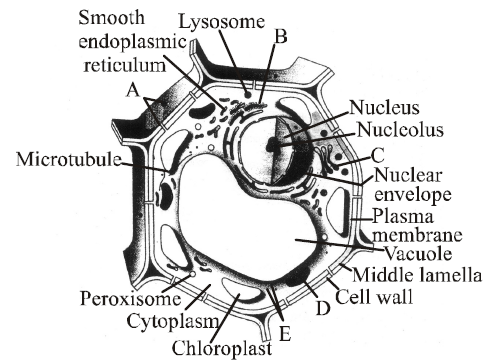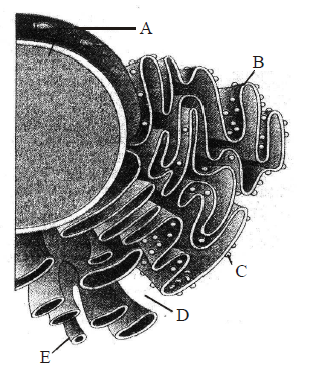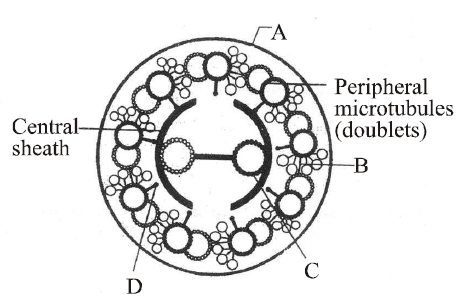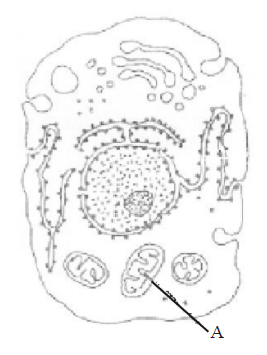In which of the following the cells are held together by a Ca-pectate layer?
Primary cell wall
Secondary cell wall
Middle lamella
Tertiary cell wall
Correct Answer :
C. Middle lamella
Middle lamella is the cementing layer between the cells. It is made up of Ca and Mg pectates.
Related Questions
The following diagram shows some of the missing structures in a plant cell marked as A, B, C, D E. Choose the option with their correct names.

A - Plasmodesmata, B - Rough endoplasmic reticulum, C - Golgi apparatus, D - Mitochondrion, E - Ribosomes
A - Desmosome, B - Rough endoplasmic reticulum, C - Golgi apparatus, D - Mitochondrion, E - Ribosomes
A - Plasmodesmata, B - Smooth endoplasmic reticulum, C - Golgi apparatus, D - Mitochondrion, E - Ribosomes
A - Tight junction, B - Rough endoplasmic reticulum, C - Golgi apparatus, D - Mitochondrion, E -Ribosomes
In which of the following the cells are held together by a Ca-pectate layer?
Primary cell wall
Secondary cell wall
Middle lamella
Tertiary cell wall
According to widely accepted fluid mosaic model cell membranes are semi-fluid, where lipids and integral proteins can diffuse randomly. In recent years, this model has been modified in several respects. In this regard, which of the following statements is incorrect?
Proteins in cell membranes can travel within the lipid bilayer.
Proteins can also undergo flip-flop movements in the lipid bilayer.
Proteins can remain confined within certain domains of the membrane.
Many proteins remain completely embedded within the lipid bilayer.
Which of the following option correctly match A, B, C, and D indicated in the given sectional view of chloroplasts.

A - Thylakoid, B-Stromal lamella, C - Stroma, D - Granum
A - Granum, B - Thylakoid, C - Stromal lamella, D - Stroma
A - Thylakoid, B - Granum, C - Stromal lamella, D - Stroma
A - Granum, B - Thylakoid, C - Stroma, D - Stromal lamella
Select the correct match of the types of neuron present in column I with its location given in column II.
| Column I | Column II |
|---|---|
| A. Centrioles | (i) Non-membrane bound organelle which helps in cell division |
| B. Fimbriae | (ii) Special structure of bacteria which help them to attach with rocks in stream and also to host tissue |
| C. Endomembrane | (iii) Includes those organelles system whose functions are coordinated |
| D. Mitochondria | (iv) Divide by fission and site of aerobic respiration |
A - (i), B - (ii), C - (iii), D - (iv)
A - (iii), B - (i), C - (ii), D - (iv)
A - (iii), B - (i), C - (iv), D - (ii)
A - (i), B - (iv), C - (iii), D - (ii)
Choose the incorrect match.
Nucleus RNA
Lysosome Protein synthesis
Mitochondria Respiration
Cytoskeleton Microtubules
Which of the following statement is false?
The ribosomes of a polysome translate the mRNA into protein.
Mitochondria divide by fragmentation.
All cell arise from pre-existing cells.
The lipid component of the membrane mainly consists of phosphoglycerides.
Read the folowing statements and identify the correct option.
- Contractile vacuole takes part in osmoregulation and excretion.
- Food vacuole is formed by engulfing the food particles.
- The vacuole is bound by a double membrane called tonoplast.
- Vacuole can occupy upto 90 percent of the volume of the cell.
(i) and (ii)
(ii) and (iv)
(i), (ii) and (iv)
None of the above
Which of the following statement of a bacterial cell is/are correct?
- Mesosome is formed by the extensions of plasma membrane into the cell.
- The pili are elongated tubular structures made up of a protein.
- Flagellum is composed of filament, hook and basal body.
- Ribosomes are about 30 nm by 50 nm in size.
(i), (ii), (iii)
All of the above
(ii) & (iv)
None of the above
Which of the following lacks cell wall?
Gametes
Amoeba
Mycoplasma
All of these
Integral proteins of cell membrane occur on/in
inner surfaces
outer surfaces
phospholipid matrix
inner and outer surfaces
Identify the components labelled as A, B, C, D and E in the diagram given below from the list (i) to (viii).

- Cristae of mitochondria
- Inner membrane of mitochondria
- Cytoplasm
- Smooth endoplasmic reticulum
- Rough endoplasmic reticulum
- Mitochondrial matrix
- Ribosome
- Nucleus
A - (viii), B - (v), C - (vii), D - (iii), E - (iv)
A - (i), B - (iv), C - (vii), D - (vi), E - (iii)
A - (vi), B - (v), C - (iv), D - (vii), E - (i)
A - (v), B - (i), C - (iii), D - (ii), E - (iv)
8.A student was given cell samples (A and B) to identify parts which are highlighted. He observed the samples under the microscope and list down the function of the part of cell sample. The information collected by the student is listed in the table below, on the basis of which the student infers that the samples contain the organelles.
| Sample A | Sample B |
|---|---|
| Make energy available for cellular metabolism | Generates ATP and synthes izes s ugar |
| Absent in cell that carry oxygen throughout the body | Present in plant cell |
| Called the energy currency of cell | Source o f all the food energy |
Identify the part highlighted in the sample A and B and explain why they were called as semi-autonomous organelles?
Sample A - Mitochondria, Sample B - Chloroplast; because both the organelles are double membrane bound structure.
Sample A- Mitochondria, Sample B - Chloroplast; because they both are capable of synthesis of their own proteins only.
Sample A - Mitochondria, Sample B - Chloroplast; because they are capable of synthesis of their own proteins and contain their own DNA.
Sample A- Mitochondria, Sample B - Chloroplast; because they contain their own DNA to transfer the genetic information from one generation to another.
pH of vacuolar cell sap is
neutral and isotonic.
alkaline and isotonic.
acidic and hypertonic.
equal to cytoplasm and isotonic.
Read the statements given below with regard to the functions performed by Golgi apparatus ?
- Transport and chemically modify the materials contained within it.
- Performs the function of packaging materials.
- Important site of formation of glycoproteins and glycolipids.
Which of the following is the correct answer ?
(i) is wrong but (ii) and (iii) are correct
(ii) is wrong but (i) and (iii) are correct
(ii) and (iii) are wrong but (i) is correct
All are correct.
Which of the following statements are correct ?
- In prokaryotic cells, a special membranous structure formed by the extension of the plasma membrane into the cell is known as polysome.
- The smooth endoplasmic reticulum is the major site for synthesis of glycoproteins.
- RuBisCO is the most abundant protein in the whole biosphere.
- Mitochondria, chloroplasts and peroxisomes are not considered as part of endomembrane system. Of the above statements
(iii) and (iv)
(i) and (ii)
(ii) and (iii)
(i) and (iv)
Match column-I with column-II and select the correct option.
| Column - I | Column - II |
|---|---|
| A. RER | I. Intracellular and extracellular digestion |
| B. Cell wall | II. Provide structural support to the cell |
| C. Flagella | III. Protein synthesis and secretion |
| D. Lysosomes | IV Responsible for cell movement |
A III, B II, C IV, D I
A II, B III, C IV, D I
A I, B III, C II, D IV
A IV, B II, C III, D I
The cytoskeleton is a proteinaceous network of fibres in the cytoplasm. It is involved in
mechanical support.
motility.
maintenace of cell-shape.
all of the above
Most of water, in mature plant cells occurs in
nucleus
cell wall
vacuoles
cytoplasm
Study the following statements on cilium or flagellum and answer the question.
- Cilium / Flagellum contains an outer ring of nine doublet microtubules surrounding two singlet microtubules.
- Cilia are smaller which work like oars, causing the movement of either the cells or surrounding fluid.
- Flagella are comparatively longer and responsible for cell movement.
- Cilium and flagellum are covered with plasma membrane.
Which of the above statements are correct?
(i) and (ii)
(i), (ii), (iii) and (iv)
(i) and (iv)
(ii) and (iii)
_______________ is the important site of formation of glycoproteins and golycolipids.
SER
Lysosome
Golgi apparatus
Mitochondria
The figure below shows the structure of a mitochondrion with its four parts labelled (A), (B), (C) and (D).

Select the part correctly matched with its function.
Part (D): Outer membrane Gives rise to inner membrane by splitting.
Part (B): Inner membrane Forms infoldings called cristae.
Part (C): Cristae Possess single circular DNA molecule and ribosomes.
Part (A): Matrix Major site for respiratory chain enzymes.
Which of the following is absent in prokaryotes?
DNA
RNA
Plasma membrane
Mitochondria
Membranous extensions in blue green algae are known as
phytochrome
chromatophore
mesosome
pneumatophore
Select the statements which are related to Schwann.
- He reported that cells have a thin outer layer which is today known as plasma membrane
- Cell wall is a unique character of the plant cell.
- Body of plants and animals are composed of cells and products of cells.
Only (i)
Only (iii)
(i) and (iii)
All of these
Identify the components labelled A, B, C and D in the given section of cilia/flagella showing different parts. Choose the option which shows the correct labelling of parts.

A Plasma membrane, B Interdoublet bridge, C Central microtubule, D Radial spoke
A Plasma membrane, B Arm, C Central microtubule, D Radial spoke
A Plasma membrane, B Interdoublet bridge, C Hub, D Radial spoke
A Plasma membrane, B Interdoublet bridge, C Hub, D Arm
Golgi apparatus is absent in
higher plants
yeast
bacteria and blue-green algae
None of the above
9.A student was given cell samples (A and B) to identify parts which are highlighted. He observed the samples under the microscope and list down the function of the part of cell sample. The information collected by the student is listed in the table below, on the basis of which the student infers that the samples contain the organelles.
| Sample A | Sample B |
|---|---|
| Make energy available for cellular metabolism | Generates ATP and synthes izes s ugar |
| Absent in cell that carry oxygen throughout the body | Present in plant cell |
| Called the energy currency of cell | Source o f all the food energy |
Explain why the samples were belonged to eukaryotic cell and not prokaryotic cell? Because,
eukaryotic cell have membrane bound organelles.
eukaryotic cell have non - membrane bound organelles.
eukaryotic cell are smaller and multiply more rapidly than prokaryotic cells.
eukaryotic cell are larger and multiply more rapidly than prokaryotic cells.
In the given figure of animal cell, one orginelle is marked as A. Select the correct identification and function of the organelle A from the given option.

Endoplasmic reticulum Synthesis of lipids.
Mitochondria Produce cellular energy in the form of ATP.
Golgi body Provides packaging material.
Lysosomes Secrete hydrolytic enzymes.
Which one of the following is not considered as part of the endomembrane system?
Golgi complex
Peroxisome
Vacuole
Lysosome
